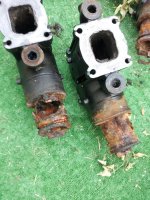The issue is on the closed cooling side and I see no indication of any corrosion as the coolant looks in new condition. And the temp sensor in exhaust manifold is along the top surface where an air pocket is likely to be.
Remember it's happening at the same time on both exhaust manifolds so some type of blockage due to corrosion in the exhaust manifolds on both sides with closed cooling is unlikely.
Air pockets could be on both sides as the exhaust manifolds are identical and at same height.
An exhaust elbow that was used in salt water can look great on the outside but could be all rotted out under the hoses where you can't see and the ONLY way to tell if your cooling passages are open is to take it apart, if you are suspecting a blockage due to hot running temps. In your case the manifolds are on the AF system but the elbows, are still raw water cooled, if they are getting clogged, maybe that is contributing to your elevated temps.
look at these Merc dry joint elbows, they look fine except for what's hidden under the rubber exhaust hoses:

and here is an OMC one piece V6 manifold I used to have on mine after 5.5 seasons in salt water, compared to new....not too bad but you can see one of the 4 exit ports is blocked with corrosion. Probably about 200 hrs of use. By 7 seasons it would have caused a major exhaust overheating problem.

So in your case I'm just guessing of course but trapped air and/or corrosion could be the cause, even if they look good outside.
With the old style Volvo and Merc wet joint exhaust as soon at they started to show rust stains on the outside you had to take em apart because that meant they could be leaking on the inside which on those systems would put water into the center exhaust passage.
In fresh water regions this is mostly a non-issue from what I hear but here in the salt pond it is regular maintenance, or else you risk engine damage from rotted out exhaust parts and safety risk due to burning up the rubber exhaust hoses.

























